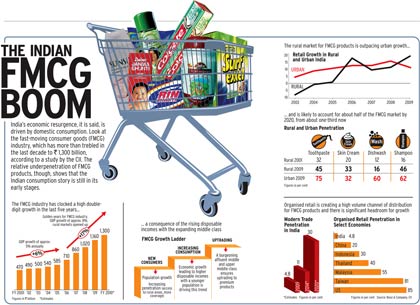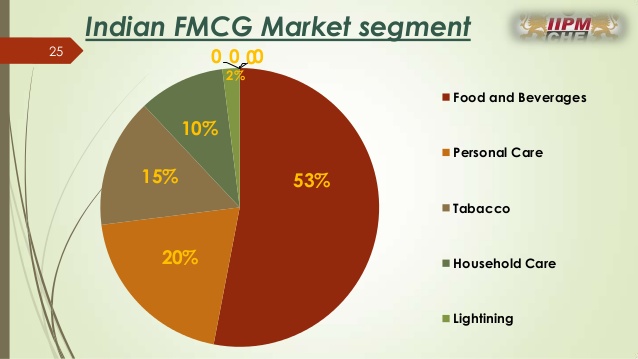The fast-moving consumer goods (FMCG) sector is the 4th largest sector in the Indian economy-boosting India’s GDP. The urban consumption of FMCG products is increasing at a faster rate. Recent years have seen the growing demand from the rural and semi-urban areas of India. The market size of the concerned sector in 2011 was US$ 31.6 billion, in 2015 it was US$ 43.1 billion and it is estimated to reach US$ 103.7 billion in 2020. But, in the financial year (FY) 2019, the market has been moving very sluggish due to certain reasons. The diverse ranges of the products which fall under the category of FMCG are Packaged food items, packaged drinks, toiletries, cosmetics, personal hygiene, chocolates, fabric care, personal care etc. The goods that are used daily by the consumers are all categorised under this sector FMCG. Since the beginning of the decade, the behavioural pattern of the Indian consumers is getting updated, predicting a prospective but bearish growth of the Indian economy.
The moderate rate of inflation and technology penetration is contributing positively in this sector and judging by the growth pattern of this sector. The retail market is estimated to reach US$ 1.1 trillion by the end of this decade. But after the introduction of GST, there has been a fall in the revenue collected from the rural areas in the FMCG sector. This decade has also witnessed steep competition between various new players. But the giant share of the industry is dominated by the most reputed names like Dabur(60%), Colgate(54.7%) and Hindustan Unilever(54%). With the break of this decade in 2010, the country has experienced some major changes like Digital Revolution, Technological Revolution and Economic Revolution. The increasing health and nutrition awareness, beauty consciousness and higher expendable income of the contemporary Indian user base are leading to the development and booming of several FMCG sub-sectors like air and water purifier, organic food staples and supplements etc.
Just like all other industries thriving on Indian soil like automotive, insurance, pharmaceutical etc (add links of other blogs) FMCG has undergone noticeable changes and progression in this decade. Let us scroll down to the following paragraphs to have a closer look!

Market Trends
With the beginning of this decade, there was a substantial positivity in the growing market trends of the Indian FMCG sector. But towards the end, it has given us quite a different picture. Nielsen revised the growth forecast of the FMCG sector from 11-12% to 9-10%. The result is due to a massive slowdown in the rural consumption rates. According to the head of retail measurement services of Nielsen South Asia “At the beginning of the year, we saw a softening, driven by essential and impulse food categories. However, the second quarter witnessed a slowdown across all food as well as non-food categories with salty snacks, biscuits, spices, toilet soaps and packaged tea leading the slowdown.”
At the beginning of the decade, the rural spends were increasing at a steady rate of 3-5% which is higher than the urban spends. Since the last quarter of 2019, the growth has been going at a snail’s pace and the rural and urban spends are at the same level now. According to Nielsen, GST has resulted in the declining of the FMCG sector as the small manufacturers could not flourish due to the inflated rates of the machines and raw materials. The market researcher also opined that the economic slowdown in the concerned sector is lead by the north and west zones, states include Madhya Pradesh, Uttar Pradesh, Haryana, Maharashtra and Assam.
According to a study conducted by Motilal Oswal, the FMCG stock market has been exceptionally quiet in the recent years, quite contrary to the other sectors who are dominating the market, like automobiles, banking and capital goods. Post GST, the market has been moving slowly, thus giving a lot of scope for future improvements.
Evolving Consumer Trends in FMCG Segment
Digitization and globalization are affecting the evolving consumer trends in full swing. The booming health and wellbeing awareness influences contemporary consumers to follow a certain trend. With the arrival of this decade, the consumers started their journey towards the evolving trends. It has certainly reached its climax by the closing of the decade. The brands have designed their market strategies to reach a broader spectrum of the Indian user base. The Big Bazaar was started by the Future Group in 2001, and by 2010-2011 it has expanded to more than 300 hyper-stores across several cities in India.

Big Bazaar has played a significant role in meeting the customer needs by providing budgeted price and a diverse range of products. The strategies like weekly Wednesday sale, various lucrative discounted offers, bigger monthly packs at a lesser price than the market, all these contributed positively to boosting the FMCG sector. Other retail chains like Spencer’s which was founded as early as in 1863, headquartered in Kolkata is another popular distribution chain in the FMCG sector. The apps like Grofers, BigBasket, Freshtohome etc have been popular among the masses. They can get their required items delivered at home at a discounted rate. Post demonetization, the secured online payment platforms like Paytm, G-Pay, BHIM helped the consumers to have a convenient mode of transaction.
The booming of the fashion industry influences the user base greatly. It leads to a surge in cosmetic and accessories sector in various eCommerce platforms like Amazon, Flipkart, Nykaa etc. Flipkart and Nykaa and other such e-commerce platforms reached the Indian mass in the first half of the decade but the technological conveniences paced their growth in the second half of the decade. The social platforms are helping the consumers to get a better idea even before they are investing in purchasing any commodity.
According to Sameer Shaikh, AGM, Regional Head-Buying & Merchandising, Bigbasket, said, “Due to social influence, people now have an easier way of expressing themselves and at times feedbacks can be negative also, forcing us to take prompt action. No doubt, digitization has widened the scope of data exchange and feedback exchange from customers, which ultimately helps us in improving our product and services.”
Investments and Initiatives in FMCG Sector
In this decade, the Indian Government has taken special concern in uplifting the infrastructural developments in the rural sectors. The government of India has allowed 100% Foreign Direct Investment (FDI) in single-brand retail and food processing and 51% in multi-brand retail. This would boost employment and supply chain, increase the visibility of FMCG retail brands and encourage more product launches. According to a report in 2015 by India Brand Equity Foundation (IBEF), personal care and makeup contribute to 47% of the total revenue in this sector. By the end of the decade, several brands are investing in this sector with new product launches in various parts of the country.
In 2019, Santoor launched pocket deo exclusively in West Bengal. In May 2018, Sanjeev Goenka Group invested US$ 14.92 million in a start-up in the FMCG sector. The closing of the decade has seen brands like ITC, Sunfeast, Future Group investing in this sector. The government has prepared Consumer Protection Bill for ensuring speedy, cost-effective and efficient business in the FMCG sector. Thus securing the needs of the consumers. Though GST has enabled the products of FMCG sector to come under a single tax bracket, still the growth has been affected as I have already mentioned in the article.

Wrap Up
The pattern of modern retail has elevated the brand consciousness in the minds of the consumers. The unstructured and unorganized FMCG sector has a long way to go to match the pace with other active sectors like insurance and automotive. The various sub-sectors thrive across the diverse economic sectors like urban, semi-urban and rural. The demand for personal care, health care, feminine hygiene, monthly packs of commodities and household items is much higher in urban and semi-urban areas. The demand for fabric care, hot beverages and tobacco is higher in rural areas. Growing smartphone penetration and internet interconnectivity, expansion of eCommerce retail sector are directly responsible for formalising the FMCG sector in India.
The FMCG sector is not unscathed from the economic slowdown; the revenue of urban and rural sectors is not at par. But there is a large scope waiting for the FMCG sector to develop and achieve a new milestone in the coming decade. Starting in 2001, the sector has shown great promise and opportunities. But momentary upheavals and shortcoming can appear in any sector, and FMCG is no exception.
The FMCG sector is directly impacting India’s economic growth. Do you want to know what else changed in this decade? Talk to our niche skilled experts now to know the diverse competitive market in greater detail! We at Vedak have an exclusive pool of experienced industry professionals and veterans who have in-depth knowledge in FMCG sectors. Contact us to know more.

